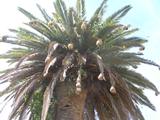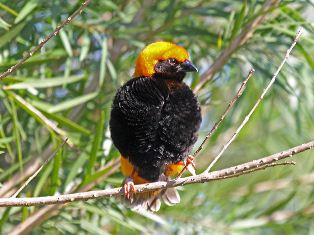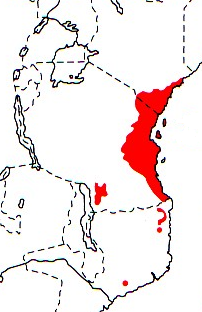Weaver news
|
The Zanzibar Bishop Euplectes nigroventris is a small East African bishop. The breeding male (photo left from wikipedia) is red and black, and is distinuished from similar bishops by an entirely red crown and forehead and lack of a red breast-band on the black underparts; it differs from the sympatric Black-winged Bishop E. hordeaceus by a short brown tail, brown wings, and red undertail-coverts. The female (photo right) and non-breeding male are smaller than the Black-winged Bishop, with a shorter bill, and with a duller buff breast-band. No subspecies of the Zanzibar Bishop are recognised and it is found in the coastal belt of south-east Kenya, southwards from Lamu; in Tanzania, on the coast including Zanzibar and Pemba Islands, westwards along the Pangani River, and an isolated inland population that is west of Songea; in northern Mozambique the distribution is less clear but occurs at Mocuba (see map below, based on Birds of Africa).
The Zanzibar Bishop inhabits coastal grasslands and cultivation. It is found in flocks, often with Black-winged Bishops, or other bishops and queleas. It feeds on grass seeds of Echinochloa haploclada, Panicum maximum, sorghum and rice. It readily feeds on termites and spiders in captivity. Their young are fed on insects. The Zanzibar Bishop is territorial, and polygynous, with up to 5 females per male. The nest (photo below from phown 2853) is a thin-walled oval structure of coarse grass with a side entrance, and grass heads project over the entrance to form a small porch. The nest is built by the male, but the female adds the lining of seed-heads of grasses such as Panicum maximum. The nest is attached to grass, bushes or reed stems, usually 1-1.5m above the ground. Early in the season, nests are usually placed in reeds or bulrushes. In Mombasa, House Crows Corvus splendens are predators on eggs and young of this species. The Zanzibar Bishop has 2 PHOWN records, both from Dar es Salaam, at a constructed wetland. The records were submitted by Anne Outwater, who provided lots of detail about the breeding attempts of this species: the female successfully raised chicks. Read more at the PHOWN record 683; also see news item. Many more PHOWN records are needed for this common species (see PHOWN summary). Submit any weaver nest records to PHOWN (PHOtos of Weaver Nests) via the Virtual Museum upload site. PHOWN summary Previous Wedn: Holub's Golden Weaver Full weaver species list |














